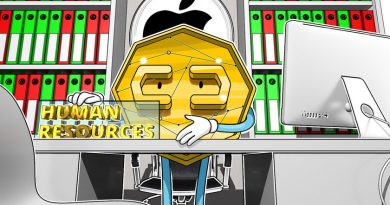The DeFi market desperately needs to connect with real-world assets
Connecting DeFi with traditional financial instruments will give a massive boost to the whole market.
With over $13 billion in total value locked, decentralized finance has truly shaken the crypto world in the last year. It has provided a new way to profit from the crypto market. Meanwhile, DeFi right now is only a niche trend with a gigantic potential to start a revolution in the business loan market. In order to grow out of diapers, DeFi desperately needs to be connected with real-world assets and exist in an environment where it can be used by real businesses, corporate clients, etc.
As a concept, DeFi truly looks like a win-win solution for those who already hold crypto, as they finally get to have some passive income from incentivization mechanisms and yield farming, and for borrowers, as they can benefit from a loan with terms that no traditional venue can offer.
Volatility and over-collateralization
However, there are several problems with DeFi that need to be addressed urgently. The first major drawback for all parties involved is over-collateralization to account for price volatility.
In most cases, protocols require borrowers to collateralize their loans at a minimum of 150% of the value of the loan. So, let’s say you want to borrow $100. That means you would have to collateralize your loan with a minimum of $150. Therefore, if your collateral drops below the $150 point in value, your loan would then be subject to a liquidation penalty.
Over-collateralization is a significant hurdle to reaching one of the main goals of DeFi: making financial services truly accessible. And the same problem occurs with stablecoins issued by DeFi protocols, as they require over-collateralization too.
Volatility of the collateral has caused losses totaling 6.65 million Dai (about $6.65 million) for Maker already and might cause more similar cases in the future.
No connection to real-world assets
This issue may be debatable, as a whole lot of people in the crypto space want to stay isolated in their own playground. However, crypto is becoming a part of a global financial system, and in order to stay there, crypto must be connected to the outside world, and there will be absolutely no growth without it.
But putting my personal views and beliefs aside, the lack of connection to real-world assets damages the DeFi space in a number of ways. First, it doesn’t allow traditional companies to borrow funds, as they can’t provide anything but crypto as collateral. The second issue is the lack of real cash flows behind protocol tokens, meaning an absence of stability in the price of protocol tokens, which are the main instrument of incentivization. In the long run, all of the above issues limit the further growth of DeFi as a paradigm and, most importantly, lead to the risk of protocols’ default due to loss of value of their tokens.
The solution for DeFi
With all issues in mind, the DeFi space requires an infrastructure that can bridge the gap between real-world assets and the DeFi ecosystem, allowing anyone to use real-world assets as collateral to borrow money from protocols.
So, will any real-world asset work? Not exactly. The asset must meet simple criteria that will allow for solving the above issues:
- The asset must be stable in order to solve volatility and over-collateralization issues.
- The asset must generate periodical fixed income in order to bring real-world cash flows.
- The price of a collateral asset must be determined in a transparent way based on several proven and recognized sources.
The asset that meets these criteria and solves the aforementioned issues comes in the form of bonds or fixed-income securities.
Why bonds will be a win-win for traditional and DeFi markets
With over $5 billion locked in DeFi lending alone and over $13 billion locked overall, it will be a perfect way for corporates to borrow money with no book-building and marketing efforts at all.
Along with that, shifting traditional financial products to the open-source and decentralized world drastically reduces the number of intermediaries required to attract financing, minimizing its cost. While in the current system, bond issuance costs may include fees paid to exchanges, payment agents, trustees, banks, lawyers and rating agencies.
If you look from the investors’ perspective, they will receive protocols with a level of stability that has never been seen on the market before. The use of bonds prevents the protocol from over-collateralization and ensures the stability of the asset, even in times of high volatility in the crypto market, therefore eliminating the risk of liquidation.
Most importantly, the use of real-world debt obligations will allow protocols to earn fixed periodical income, which can be distributed among investors. Basically, it will allow DeFi investors to benefit both from income generated by the collateral and interest payments made by borrowers.
Hurdles to building such a system
Generally speaking, DeFi is isolated from traditional finance. The first, most obvious problem is that DeFi borrowing requires collateral in the form of digital assets. Currently, there is no ready-to-go infrastructure to use real-world assets as collateral in DeFi protocols.
The next problem is heavily tied in with the whole structure of the DeFi market now: Borrowers are able to attract funds from DeFi protocols strictly in crypto, and the same occurs to interest payments. As corporates operate in the traditional system, borrowing funds and debt repayment must be set in fiat.
And the last problem is the absence of a traditional legal framework when borrowing from a protocol. There are no formal agreements in place, which raises difficulties for the accounting treatment of borrowed funds.
Conclusion
I believe that the DeFi market desperately needs to build a regulated bridge with the traditional financial market in order to ensure stable growth. Simultaneously, corporate institutions — both holders and issuers of debt securities — will be willing to take the best of DeFi infrastructure and benefit from a loan with terms that no traditional venue can offer.
Connection with fiat cash flows mixed with fixed periodic income will allow investors in DeFi to benefit both from income generated by the collateral that lies inside the protocol and interest payments paid by borrowers. At the same time, stable real-world collateral such as bonds reduces the risk of liquidation to a minimum, ensuring the stability of the protocol.
In order to achieve that, the DeFi market requires complex infrastructural solutions that will ensure compliance with current regulation for corporate institutions, allowing them to access funds and repay loans in fiat. At the same time, such infrastructure will need to be operated with the interest of the DeFi community in mind, therefore ensuring correct interaction between bonds and protocols.
The views, thoughts and opinions expressed here are the author’s alone and do not necessarily reflect or represent the views and opinions of Cointelegraph.




